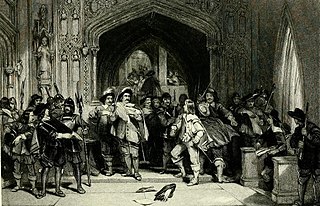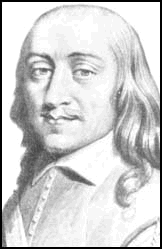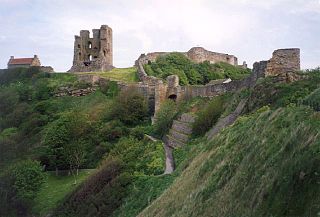
The Long Parliament was an English Parliament which lasted from 1640 until 1660. It followed the fiasco of the Short Parliament, which had convened for only three weeks during the spring of 1640 after an 11-year parliamentary absence. In September 1640, King Charles I issued writs summoning a parliament to convene on 3 November 1640. He intended it to pass financial bills, a step made necessary by the costs of the Bishops' Wars against Scotland. The Long Parliament received its name from the fact that, by Act of Parliament, it stipulated it could be dissolved only with agreement of the members; and those members did not agree to its dissolution until 16 March 1660, after the English Civil War and near the close of the Interregnum.

Henry Rich, 1st Earl of Holland, was an English courtier and politician executed by Parliament after being captured fighting for the Royalists during the Second English Civil War. Younger brother of Robert Rich, 2nd Earl of Warwick, a Puritan activist and commander of the Parliamentarian navy during the Wars of the Three Kingdoms, Henry was better known as an "extravagant, decorative, quarrelsome and highly successful courtier".

William Goffe, c. 1613/1618 - 1679/1680, was a religious radical from London who fought for Parliament during the Wars of the Three Kingdoms. Nicknamed “Praying William” by contemporaries, he approved the Execution of Charles I in January 1649, but escaped prosecution as a regicide by fleeing to the New England Colonies.

Denzil Holles, 1st Baron Holles, was an English statesman, best remembered as one of the Five Members whose attempted arrest by Charles I in January 1642 sparked the First English Civil War.

Pride's Purge is the name commonly given to an event that took place on 6 December 1648, when soldiers prevented members of Parliament considered hostile to the New Model Army from entering the House of Commons of England.

Sir William Waller JP was an English soldier and politician, who commanded Parliamentarian armies during the First English Civil War. Elected MP for Andover to the Long Parliament in 1640, Waller relinquished his military positions under the Self-denying Ordinance in 1645. Although deeply religious and a devout Puritan, he belonged to the moderate Presbyterian faction, who opposed the involvement of the New Model Army in politics post 1646. As a result, he was one of the Eleven Members excluded by the army in July 1647, then again by Pride's Purge in December 1648 for refusing to support the Trial of Charles I, and his subsequent execution in January 1649.

Sir Hardress Waller was born in Kent and settled in Ireland during the 1630s. A first cousin of Parliamentarian general William Waller, he fought for Parliament in the Wars of the Three Kingdoms, becoming a leading member of the radical element within the New Model Army. In 1649, he signed the death warrant for the Execution of Charles I, and after the Stuart Restoration in 1660 was condemned to death as a regicide.

The First English Civil War took place in England and Wales from 1642 to 1646, and forms part of the 1639 to 1653 Wars of the Three Kingdoms. An estimated 15% to 20% of adult males in England and Wales served in the military at some point between 1639 and 1653, while around 4% of the total population died from war-related causes. These figures illustrate the widespread impact of the conflict on society, and the bitterness it engendered as a result.

Colonel Thomas Horton, January 1603 to October 1649, was a member of the minor gentry from Leicestershire who served in the Parliamentarian army during the Wars of the Three Kingdoms. Like many other of those who approved the Execution of Charles I in January 1649, Horton was a religious Independent. His family was closely connected to Sir Arthur Haselrig, one of the Five Members whose attempted arrest by Charles I in January 1642 was a major step on the road to the First English Civil War.

Sir Edward Rossiter was an English landowner, soldier and politician from Lincolnshire. He fought with the Parliamentarian army in the Wars of the Three Kingdoms, and sat as an MP at various times between 1646 and 1660.

Colonel John Birch was a soldier and politician from Manchester in England. He fought for the Parliamentarians in the First English Civil War, and was a Member of Parliament at various times between 1646 and 1691.

Sir Michael Livesey, 1st Baronet, also spelt Livesay, was a Puritan activist and Member of Parliament who served in the Parliamentarian army during the Wars of the Three Kingdoms. He was one of the regicides who approved the Execution of Charles I in January 1649.
The Committee of Both Kingdoms was a committee set up during the Wars of the Three Kingdoms by the Parliamentarian faction in association with representatives from the Scottish Covenanters, after they made an alliance in late 1643.

Thomas Rainsborough, or Rainborowe, 6 July 1610 to 29 October 1648, was an English religious and political radical who served in the Parliamentarian navy and New Model Army during the Wars of the Three Kingdoms. One of the few contemporaries whose personal charisma and popularity rivalled that of Oliver Cromwell, he has also been described as "a soldier of impressive professional competence and peerless courage".

Sir Edward Harley was an English politician from Herefordshire. A devout Puritan who fought for Parliament in the First English Civil War, Harley belonged to the moderate Presbyterian faction, which opposed the involvement of the New Model Army in the peace negotiations that followed victory in 1646. Elected MP for Herefordshire in 1646, he was one of the Eleven Members forced into temporary exile by the army in 1647.
The Treaty of Newport was a failed treaty between Parliament and King Charles I of England, intended to bring an end to the hostilities of the English Civil War. Negotiations were conducted between 15 September 1648 and 27 November 1648, at Newport, Isle of Wight, on the initial proviso that they would not take longer than forty days. Charles was released on parole from his confinement at Carisbrooke Castle and lodged in Newport.

James Berry, died 9 May 1691, was a Clerk from the West Midlands who served with the Parliamentarian army in the Wars of the Three Kingdoms. Characterised by a contemporary and friend as "one of Cromwell's favourites", during the 1655 to 1657 Rule of the Major-Generals, he was administrator for Herefordshire, Worcestershire, Shropshire and Wales.

Sir Theophilus Jones, was an Irish soldier and government official of Welsh descent. One of five sons born to Lewis Jones, Bishop of Killaloe in the Church of Ireland, he formed part of a close-knit and powerful Protestant family.

Sir Humphrey Bennet (1605–1667) was a Hampshire landowner who fought for the Royalists in the First English Civil War, in which he rose to the command of a cavalry brigade. He went into exile in 1645, returned home in 1646 and was active in a number of Royalist conspiracies during The Protectorate.

The Battle of St Neots on 10 July 1648 was a skirmish during the Second English Civil War at St Neots in Cambridgeshire. A Royalist force led by the Earl of Holland and Colonel John Dalbier was defeated by 100 veteran troops from the New Model Army, commanded by Colonel Adrian Scrope.


















